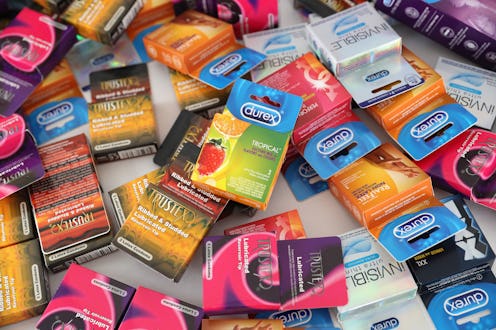
The Galactic Cap condom made waves a few weeks ago for being the future of safe sex — but hold your horses, Galactic Cap. There’s a new kid in town, and it’s throwing its glove down to challenge you. If it's successful, the hydrogel condom will be the undisputed champion of safe sex in the future. Isn't science awesome?
Here's the deal: Back in March of 2013, the Bill and Melinda Gates Foundation announced a campaign intended to give the field of sexual health an innovative boost: “Develop the Next Generation of Condom.” The 11th round of the Grand Challenges Exploration, its goal was to invent a new condom that “significantly preserves or enhances pleasure, in order to improve uptake and regular use”; bonus points could also be awarded for how easy it is to use and whether it “[addresses and overcomes] cultural barriers.” So, basically, the challenge was to make a condom that a) is sturdy enough to protect against pregnancy and STIs, b) feels as good as or better than bareback, and c) is easy to use, so as to promote and increase practices of safe sex. A noble goal, no? Over 1,000 groups of researchers entered the challenge; 52 were awarded $100,000 grants, one of which was a team from the University of Wollongong in Australia. Last week, they announced via YouTube that they’re hard at work on their version of Condoms: The Next Generation. The secret ingredient, of course, is the aforementioned hydrogels.
As Salon pointed out, if you wear contact lenses, you probably already have some experience with hydrogels, even if you don’t know exactly what they are. They’re mostly water held together by a very small amount of polymers, which makes them soft, wet materials with properties similar to those of body tissues. The Wollongong researchers are hoping that they can use hydrogels to make something like human skin, which would result in a tough, transparent, and latex-free condom (so, excellent news for those of you out there who are allergic to latex). They’d be expensive to make, initially, but thanks to the wonders of 3D printing, it might still be possible to mass produce them efficiently and affordably.
Here, I’ll let the scientists tell you a little more about the whole thing themselves:
The possibility of these hydrogel condoms is especially good news in light some of the concerns about Galactic Caps that have recently emerged. Nerve has a pretty thorough discussion about it, but the salient points are these: First, the Galactic Cap only covers the head of the penis, leaving the whole shaft exposed — even though some STIs can be transmitted not only through the exchange of bodily fluids, but also through skin-to-skin contact; second, it doesn’t deal with oral sex protection; and third, the possibility for misuse is way too high (a huge number of people have a hard enough time just using a regular condom, so trying to figure out how this cap thing works might be a disaster waiting to happen). The hydrogel condom, on the other hand, covers the entire penis, and though it’s not idiot-proof, it’s about as easy to use as a latex condom — as well as likely feeling better than a latex condom. I don’t know about you, but anything that makes sex both fun and safer sounds like a good idea to me. Go forth, University of Wollongong! Bring us new and exciting innovations! Safe sex for all!